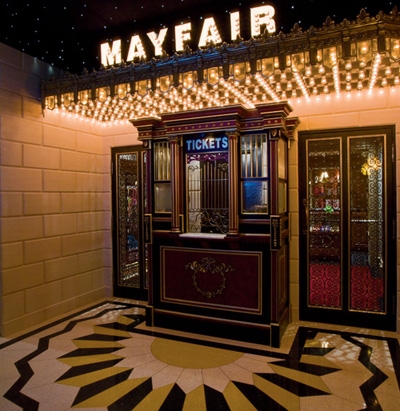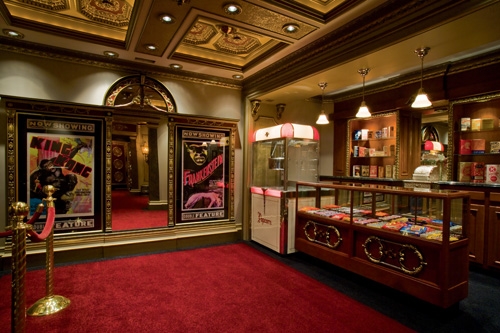Glory Days Page 2

Eric initially envisioned a layout where you would walk straight from the concession area into the lobby and then into the theater. But Theo came up with a much more involved, and involving, floor plan in the form of a giant U. "Which is deceiving," Eric says. "It makes the space seem much bigger than it is because you're moving from room to room."
From the first floor of the house, a set of limestone steps descends to the box office, which uses a fiber-optic ceiling, limestone walls, a large poster holder, and an antique-style marquee to create the illusion of being outside. "I had a hard time finding a ticket booth that was the right size and scale," Eric says, "so I ended up buying some bank-teller fronts that I thought would, after some slicing and dicing, make a pretty neat booth." The doors to either side of the booth are from Architectural Artifacts.
"Unfortunately, we had to chop 18 inches off [from their height] to get them in scale to fit that area."
Eric wanted to have a manne- quin in the ticket booth, but his wife, Susan, was dead-set against it. "She has a phobia about clowns and mannequins, so she told me, 'If you put a mannequin in there, I get a German shepherd.' I'm not ready for another dog yet."

From the box office, you enter the concession area, which features a display case with candy, an antique cash register, and a 1940s Manley popcorn machine - all of it restored by Eric. The popcorn machine isn't from the same era as the rest of the theater's fixtures, but Eric found ways to integrate it into the overall scheme. "It's Art Deco," he says, "but the pendant lights over the display case and the cash register both have a bright nickel finish, which ties in with the chrome elements in the machine, pulling it into the color scheme. Only a purist would know that it's out of scale or out of date."
The concession area also features a massive wall fixture with two large poster holders to either side of a mirror, four large horsehair-plaster ceiling coffers from a Chicago mansion, antique exit signs, and an intriguing ship's-wheel ticket grinder. "They would shred your ticket in it so you couldn't reuse it," Eric explains.
From the concession area, you turn right to enter the lobby, an elaborate eight-sided space incorporating most of the elements recovered from the Mayfair. "It has two iron three-sheet poster holders on the main side walls, four very ornate sconces, and a single large ceiling fixture - all from the Mayfair," says Eric. "The four cigarette urns came from the Murat Theatre in Indianapolis."
As beautiful as they are, the light fixtures caused a bit of a controversy - especially the chandelier. "The Mayfair had a Spanish Moorish theme, so it had pretty wild-looking fixtures," Eric says. "When Theo first saw them, he thought they were hideous because they had multicolored, round glass jewels in them. He said it looked like a carnival. But I replaced all the glass jewels with amber-colored ones, which toned the fixtures way down."

The restroom features two-way mirrors with 19-inch Sharp LCD TVs behind them so that guests don't have to miss the movie.
As you walk through the lobby, it's natural to assume that the large double doors at the end (also from the Mayfair) lead into the theater. But they instead lead into (of all places) the restroom. "I wanted an older-looking style," Eric says, "and to me that means a pedestal sink and lots of Carrera marble." The most unusual thing in the room is the pair of two-way mirrors above the sink and the toilet, which have 19-inch Sharp LCD TVs behind them so guests don't have to miss any of the movie.
Eric had to be careful to integrate the restored elements so that his Mayfair would feel like a 1920s movie theater and not like a museum. "The sad thing is that I wasn't able to use some items," he says, "including a Powers carbon-arc movie projector and a restored oak-cabinet movie camera."
By this point, you've navigated the giant U and are about to enter the theater proper. But that gratification is deferred a moment longer by a small gallery space located to the immediate right of the lobby. The gallery, which is made up of a series of steps running along the left side of the theater (as you face the screen), was the product of necessity. The theater began as a 20 x 30-foot space, but by the time the stage was added, its dimensions had become closer to 20 x 20 - which, as Eric points out, "isn't good acoustically." So Theo suggested adding the gallery, which not only changed the theater back into a sonically friendlier rectangle but also gives people a way to discreetly get to and from their seats during a movie. "That's something I never would have thought of," Eric says.
Something he did think of was adding mirrors to the front of the equipment room at the end of the gallery. "The door was a distraction," he says. "Putting mirrors on and above it creates the illusion of doubling the length of the gallery. So, by solving that problem, we actually enhanced the look of the area."

Turning to the right when you first enter the gallery takes you into the bar area in the back of the theater. "It's the most useful area in there," Eric says, "because you're sitting up on bar stools, and you can have food and drink and not have to worry about spills, but yet you still have a great view of the screen."
The main theater area is filled with two rows of six large seats from Fortress Seating. "I went with a very traditional style in order to have the 1920s look," Eric says. "There are seats that are more comfortable, but it was more important to have the right look instead of going with some of the real plush leathery seats that are out there."
All the anticipation created by the progression from box office to concession area to lobby would build to a tremendous letdown if the theater itself wasn't stunning. But the lush yet cozy burgundy-and-gold room delivers, successfully evoking the great movie palaces within a fairly modest space. For all its flash, the color scheme is actually toned down a bit from Eric's original plan. "I assumed it would be filled with bright 24-karat-looking gold," he says. "But Theo was like, 'No, no, no. You don't want it looking like it's dripping in gold. You want it subdued.' So everything has been antiqued to create the impression of an old-time theater in perfect condition."




























































